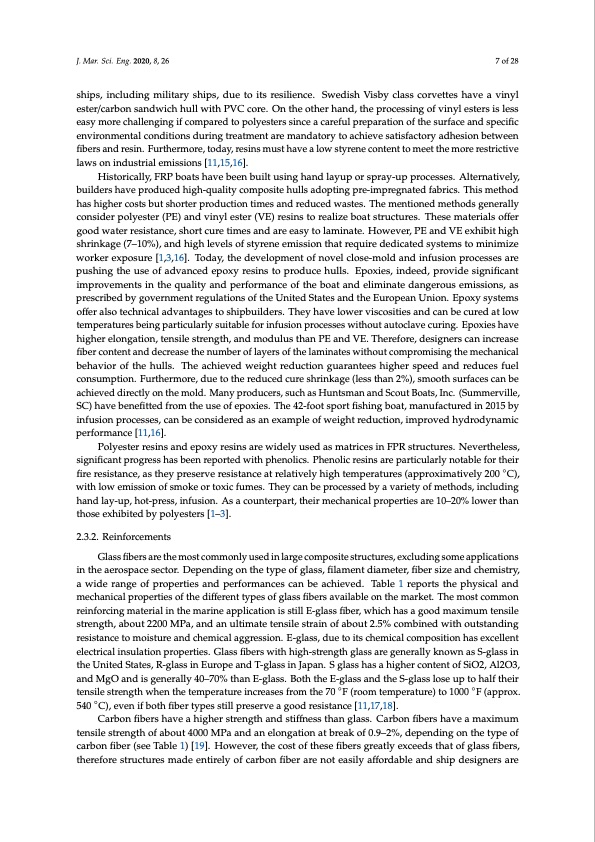
PDF Publication Title:
Text from PDF Page: 007
J. Mar. Sci. Eng. 2020, 8, 26 7 of 28 ships, including military ships, due to its resilience. Swedish Visby class corvettes have a vinyl ester/carbon sandwich hull with PVC core. On the other hand, the processing of vinyl esters is less easy more challenging if compared to polyesters since a careful preparation of the surface and specific environmental conditions during treatment are mandatory to achieve satisfactory adhesion between fibers and resin. Furthermore, today, resins must have a low styrene content to meet the more restrictive laws on industrial emissions [11,15,16]. Historically, FRP boats have been built using hand layup or spray-up processes. Alternatively, builders have produced high-quality composite hulls adopting pre-impregnated fabrics. This method has higher costs but shorter production times and reduced wastes. The mentioned methods generally consider polyester (PE) and vinyl ester (VE) resins to realize boat structures. These materials offer good water resistance, short cure times and are easy to laminate. However, PE and VE exhibit high shrinkage (7–10%), and high levels of styrene emission that require dedicated systems to minimize worker exposure [1,3,16]. Today, the development of novel close-mold and infusion processes are pushing the use of advanced epoxy resins to produce hulls. Epoxies, indeed, provide significant improvements in the quality and performance of the boat and eliminate dangerous emissions, as prescribed by government regulations of the United States and the European Union. Epoxy systems offer also technical advantages to shipbuilders. They have lower viscosities and can be cured at low temperatures being particularly suitable for infusion processes without autoclave curing. Epoxies have higher elongation, tensile strength, and modulus than PE and VE. Therefore, designers can increase fiber content and decrease the number of layers of the laminates without compromising the mechanical behavior of the hulls. The achieved weight reduction guarantees higher speed and reduces fuel consumption. Furthermore, due to the reduced cure shrinkage (less than 2%), smooth surfaces can be achieved directly on the mold. Many producers, such as Huntsman and Scout Boats, Inc. (Summerville, SC) have benefitted from the use of epoxies. The 42-foot sport fishing boat, manufactured in 2015 by infusion processes, can be considered as an example of weight reduction, improved hydrodynamic performance [11,16]. Polyester resins and epoxy resins are widely used as matrices in FPR structures. Nevertheless, significant progress has been reported with phenolics. Phenolic resins are particularly notable for their fire resistance, as they preserve resistance at relatively high temperatures (approximatively 200 ◦C), with low emission of smoke or toxic fumes. They can be processed by a variety of methods, including hand lay-up, hot-press, infusion. As a counterpart, their mechanical properties are 10–20% lower than those exhibited by polyesters [1–3]. 2.3.2. Reinforcements Glass fibers are the most commonly used in large composite structures, excluding some applications in the aerospace sector. Depending on the type of glass, filament diameter, fiber size and chemistry, a wide range of properties and performances can be achieved. Table 1 reports the physical and mechanical properties of the different types of glass fibers available on the market. The most common reinforcing material in the marine application is still E-glass fiber, which has a good maximum tensile strength, about 2200 MPa, and an ultimate tensile strain of about 2.5% combined with outstanding resistance to moisture and chemical aggression. E-glass, due to its chemical composition has excellent electrical insulation properties. Glass fibers with high-strength glass are generally known as S-glass in the United States, R-glass in Europe and T-glass in Japan. S glass has a higher content of SiO2, Al2O3, and MgO and is generally 40–70% than E-glass. Both the E-glass and the S-glass lose up to half their tensile strength when the temperature increases from the 70 ◦F (room temperature) to 1000 ◦F (approx. 540 ◦C), even if both fiber types still preserve a good resistance [11,17,18]. Carbon fibers have a higher strength and stiffness than glass. Carbon fibers have a maximum tensile strength of about 4000 MPa and an elongation at break of 0.9–2%, depending on the type of carbon fiber (see Table 1) [19]. However, the cost of these fibers greatly exceeds that of glass fibers, therefore structures made entirely of carbon fiber are not easily affordable and ship designers arePDF Image | Marine Application of Fiber Reinforced Composites

PDF Search Title:
Marine Application of Fiber Reinforced CompositesOriginal File Name Searched:
jmse-08-00026.pdfDIY PDF Search: Google It | Yahoo | Bing
Development of a solar powered Electric Ship The Electricship website originally started off as a project to develop a comprehensive renewable, affordable, modular electric ship... More Info
Modular Boat Hull Composite The case for a unsinkable, modular composite hybrid boat hull... More Info
MS Burgenstock Hybrid Electric Catamaran Lake Lucerne Unique shuttle servicing Lucerne to the Burgenstock Resort... More Info
Ground Power Unit GPU Powered by Lithium Ion Batteries The goal of the Ground Power Unit is to provide a readily accessible, modular, ready-to-power solution for remote power... More Info
| CONTACT TEL: 608-238-6001 Email: greg@electricship.com | RSS | AMP |